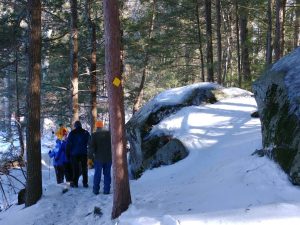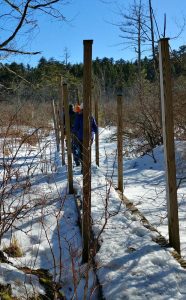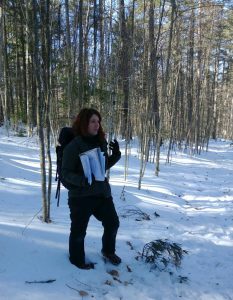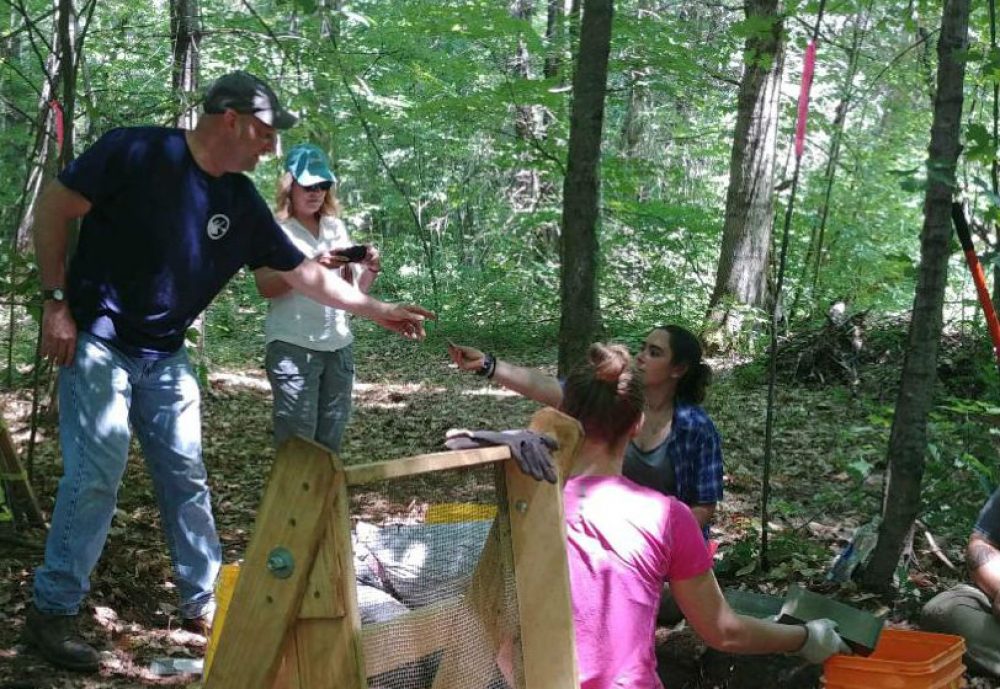Clues to Past Cultures
(refer to important disclosure statement at end of post)
Andria Moglia edited by Mary Ann McGarry
Exploring the culture of the people who once inhabited the sites we now occupy can help us make a connection with our community. Such place based learning can engender stewardship of rich archaeological and historical resources. Livermore Falls is a site worth preserving for its many natural features and as we are discovering the layers of archaeological treasures from many settlements- spanning pre-European Native Americans to mill operations to the current status of being a NH State Park under development. Take a Trip Back In Time. Imagine it is the year 1820 and you awaken before dawn to the running river outside your window; the rooster squawking, and the yelling of workers entering the mill for their morning shift. You get out of bed to eat breakfast before going to work at the Tannery next door. Your mother and father are having coffee in the kitchen as you walk in to join them. You are 12 years old and do not go to school; the only friends you have are the ones next door and across the dirt road; you work at a shoe shop with your father. One day on your break at work, you find a slightly curved rock that has slightly, uniform raised ridges. On first glance the piece looked like a piece of hardened, consolidated earth. You wonder about who created and handled this piece of pottery. In examining the material carefully, you notice the grooves and edges of the piece and fixate on the patterns. The pottery piece is more reddish in color in contrast to the soil in which it was found. You take it to your father at the tannery and he doesn’t seem to care as much as you do, so you take it home and put it in a safe place. Days later you find another piece. The edges fit together just like puzzle pieces.

Figure 1. The tannery area of the Hollow, 1875, looking upstream, Pemi River is to the left, area is now forested.
Archaeologists like piecing together stories about past cultures. To do so accurately, they have developed a set of protocols and they rely on multiple sources- artifacts like the pottery piece and historical documents to determine who lived where, when, and how. Patterns on pottery is one way to date cultures. Information gathered from multiple sites in an area helps complete and verify records. Pre-woodland sites have been documented on the Pemi River downstream from Livermore Falls. Surely, the pool at the bottom of the falls was a great site for fishing and camping during salmon migrations.

Pottery piece extracted from SCRAP Archaeological Dig, Livermore Falls, NH, summer 2018
Abenaki Who?
You may be wondering, what does Abenaki even mean, and who were they? They are just like you and me, except they existed 2,000 or more years ago (David Trubey). They hunted and fished for their food and used the nearby river, known as Livermore Falls, for many purposes. Their presence portrayed a natural lifestyle, one that many, today could not obtain. Through the findings of miniscule pieces (flakes), archaeologists can say that the Abenaki tribe did not just pass through New Hampshire but remained for a long period of time. According to UnionLeader.com, “All Abenaki were killed off in the early 1700’s, which could not be true referring to historical records that showed Abenaki families living and interacting in communities across New Hampshire”. By understanding why certain artifacts were made this way, or why it was found in that location is what archaeologists try to answer when conducting digs. Then, they try to uncover who made the artifact, what brought them there to settle and for what purposes did they make the object for. The power that comes from the artifact is incomprehensible; to hold it and feel its value is an unforgettable experience, and I now see why archaeologists love their jobs. If you ever get the chance to work in the field with experienced diggers, take the opportunity, and get to know the land in which you stand on, because one day you will be leaving something behind that someone will someday find, and ask the same questions we do.
Scrap
David Trubey and Edna Freighner are two important leaders of SCRAP (State Conservation and Rescue Archaeology Program) excavations. They work to ensure proper preservation techniques are used, and instruct all participants on helpful skills needed to handle the task at hand. Before beginning a SCRAP dig, the first step includes the where; where will this dig begin, and how do we know that this location could be an area with possible findings. When discussing these questions with David and Edna, the most important step to consider is to observe historical maps of the site before allotting time to set up a dig. First, you want to observe previous maps that give clues to major objects that could have been left behind. For example, at Livermore Falls, there are cellar hollows, and stone walls that indicate there were previous peoples living there. “The next characteristic to look for is a major water source within 200 meters of the terrain. This is because these water sources not only provided safe drinking water, but food sources such as fishing and water fowl (Trubey).” Archaeologists also acknowledge soil type when looking for areas of pre-contact (hearth compromised of fire-altered rocks and charcoal) or post- contact (cellar holes) archeological sensitivity; they work around what is already there to determine the land in which it was hundreds of years ago.
There are specific sampling protocols to follow at archaeological sites. According to archaeologist David Trubey, once a dig is officially ready to be tested, “Transects are spaced eight meters apart along a compass heading. Shovel test pits (50 cm x 50 cm) are then dug at eight-meter intervals. This method creates a grid over the land form, ensuring the area is sufficiently tested. If any archaeological feature is found, then the next step is to dig one meter by one-meter excavation units," (conversation with David Trubey).
Who Cares?
Who cares about the past, if it isn't part of our modern daily lives, why does it matter? We tend to care about topics that relate to us, and hold meaning in our lives. David Trubey and Edna Frieghner have conducted SCRAP digs with college students and community members in the Plymouth area and other locations in New Hampshire to explore and unravel the past as recorded in buried sediments. The SCRAP digs literally bring history to people's fingertips as volunteer workers shift and shovel through different layers of soils exploring evidence of people who previously inhabited the land.
Past, Present, Future
Think about all the items you use in your everyday life, like cell phones, toothbrushes and so on. With more than seven billion people on this planet the amount of trash and “artifacts” from our consumer lifestyle that will be left behind is staggering. Archaeological digs show a time lapse of what occurred on the land overtime. The left behind objects at Livermore Falls include: pieces of shoes, nails, flakes chipped from rocks, rusted horseshoes, and more. The amazing story at Livermore Falls is that there is evidence from multiple cultures through time, beginning with Native Americans before the arrival of Europeans continuing through all the mills that operated on the banks of the Pemi River. “For the historic period, archaeological sites balance, expand, corroborate and contradict the written and oral records of the past,” (nhdhr). The future of the Livermore Falls site is the creation of a State Park that will provide interpretation about the history that was preserved at the site. The story is still unfolding as information is brought to light through the SCRAP digs.
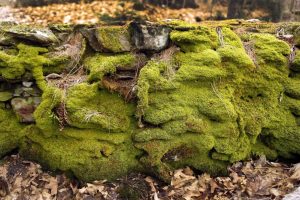
Figure 2. Moss covers the remains of a foundation in an area known as the Hollow, Campton side of the River, downstream from the falls
Conclusion
History is embedded within the soils beneath our feet at Livermore Falls. Learning about cultures that preceded us in the Plymouth, NH area is partly understanding how and why we are here.

Photo by: Andria Moglia
Disclosure note:
As a responsible member of society, it is important to keep in mind that archaeological sites, including those found at Livermore State Forest, are nonrenewable resources. We have to be aware that these sites hold information from pre and post contact life which can easily be lost forever. As these sites are also a part of a NH State Forest, it is ILLEGAL to remove artifacts, dig or metal detect. This is a place where good stewardship is necessary to preserve the landscape’s historical and natural features for future generations.
References:
Biello, Peter. “Digging Up Evidence of New Hampshire's Earliest Inhabitants.” New Hampshire Public Radio, 12 June 2017, www.nhpr.org/post/digging-evidence-new-hampshires-earliest-inhabitants#stream/0.
Brooks, David. “Archaeology Camps Take You Back 200 or 2,000 Years in NH.” Concord Monitor, 2 Apr. 2016, www.concordmonitor.com/News/Local/Archaeology-camps-take-you-back-200-or-2-000-years-in-NH-1214764.
Feighner, Edna, Archaeologist. NH Division of Historical Resources. Personal interaction - Fall, 2018.
McCormack, Kathy, Associated Press. “Can You Dig It? Archaeology Field Program Will Explore New Hampshire Mill Town That Vanished.” Associated Press. Apr. 2016, www.pressherald.com/2016/04/02/dig-will-explore-new-hampshire-mill-town-that-vanished/.
SCRAP Field in Historical Archaeology. The “Hollow” Livermore Falls, NH July 9-August 3, 2018. Retrieved November 13, 2018. https://www.nh.gov/nhdhr/scrap_info.html.
Trubey, David, Archaeologist. NH Division of Historical Resources. Personal interaction- Fall, 2018.



